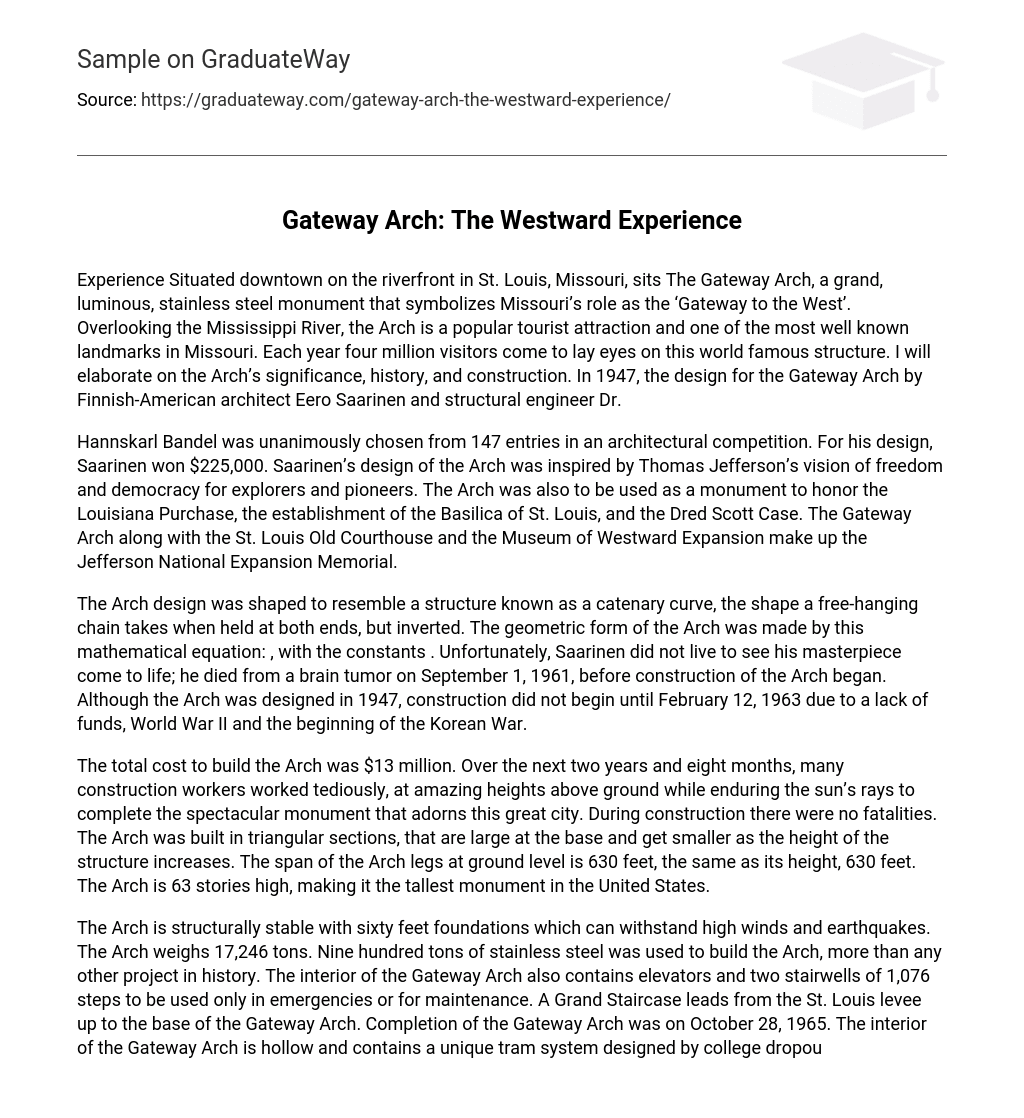Experience Situated downtown on the riverfront in St. Louis, Missouri, sits The Gateway Arch, a grand, luminous, stainless steel monument that symbolizes Missouri’s role as the ‘Gateway to the West’. Overlooking the Mississippi River, the Arch is a popular tourist attraction and one of the most well known landmarks in Missouri. Each year four million visitors come to lay eyes on this world famous structure. I will elaborate on the Arch’s significance, history, and construction. In 1947, the design for the Gateway Arch by Finnish-American architect Eero Saarinen and structural engineer Dr.
Hannskarl Bandel was unanimously chosen from 147 entries in an architectural competition. For his design, Saarinen won $225,000. Saarinen’s design of the Arch was inspired by Thomas Jefferson’s vision of freedom and democracy for explorers and pioneers. The Arch was also to be used as a monument to honor the Louisiana Purchase, the establishment of the Basilica of St. Louis, and the Dred Scott Case. The Gateway Arch along with the St. Louis Old Courthouse and the Museum of Westward Expansion make up the Jefferson National Expansion Memorial.
The Arch design was shaped to resemble a structure known as a catenary curve, the shape a free-hanging chain takes when held at both ends, but inverted. The geometric form of the Arch was made by this mathematical equation: , with the constants . Unfortunately, Saarinen did not live to see his masterpiece come to life; he died from a brain tumor on September 1, 1961, before construction of the Arch began. Although the Arch was designed in 1947, construction did not begin until February 12, 1963 due to a lack of funds, World War II and the beginning of the Korean War.
The total cost to build the Arch was $13 million. Over the next two years and eight months, many construction workers worked tediously, at amazing heights above ground while enduring the sun’s rays to complete the spectacular monument that adorns this great city. During construction there were no fatalities. The Arch was built in triangular sections, that are large at the base and get smaller as the height of the structure increases. The span of the Arch legs at ground level is 630 feet, the same as its height, 630 feet. The Arch is 63 stories high, making it the tallest monument in the United States.
The Arch is structurally stable with sixty feet foundations which can withstand high winds and earthquakes. The Arch weighs 17,246 tons. Nine hundred tons of stainless steel was used to build the Arch, more than any other project in history. The interior of the Gateway Arch also contains elevators and two stairwells of 1,076 steps to be used only in emergencies or for maintenance. A Grand Staircase leads from the St. Louis levee up to the base of the Gateway Arch. Completion of the Gateway Arch was on October 28, 1965. The interior of the Gateway Arch is hollow and contains a unique tram system designed by college dropout Dick Bowser.
He and his father developed, manufactured and installed elevator equipment. He was chosen to design the transportation system of the Arch. Bowser’s tram system consisted of two eight capsule trains, one in each leg of the Arch. Each tram can carry five passengers up to the observation deck at the top of the Arch. The trams travel at an average speed of 4mph and are very quiet and completely safe. It takes four minutes to ride to the top of the Arch and three minutes to descend to the ground level. Bowser, also known as a second generation elevator man, designed the tram system in just two weeks!
He was paid forty thousand dollars for his design. The transportation system was built at a cost of three and a half million dollars. The north tram was opened to the public on July 24, 1967 and the south tram was completed in 1968. A million visitors ride the trams each year. The observation deck of the Gateway Arch offers visitors a 30 mile panoramic city view. The Museum of Western Expansion is located underground, along with theaters showing the Arch’s construction and the history of Lewis & Clarks arrival to the West and two gift shops.
The museum also spotlights guest appearances from a big black bear, Sacagawea and a Buffalo soldier. In commemoration of The Gateway Arch’s 50th anniversary, a design competition was launched by the City Arch River 2015 Foundation to renovate the Arch’s grounds. Construction work is set to be completed October 28, 2015. The Gateway Arch is a monument that has to be seen in person. The magnitude of this man made monument is lost in pictures of any kind. In my opinion, the Arch is an amazing attraction that everyone should visit at least once.





